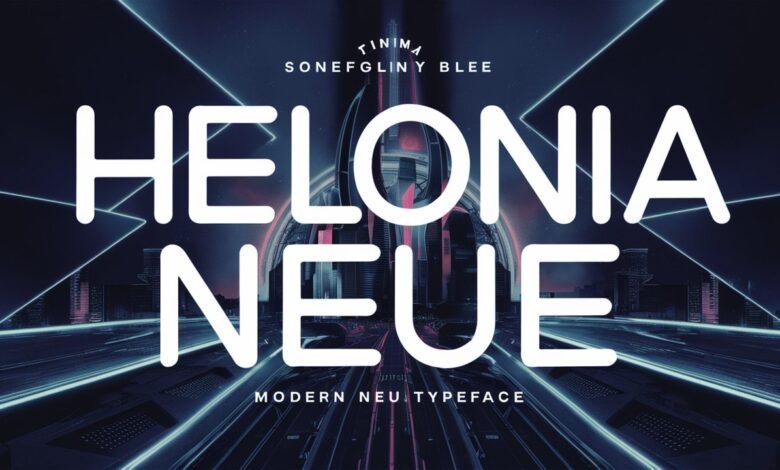Helonia Neue: The Modern Typeface Redefining Digital Design and Branding

In an era where visual identity defines success, typography has emerged as a cornerstone of digital and print communication. Among the myriad of typefaces vying for attention, Helonia Neue has carved a unique niche, blending minimalist aesthetics with functional versatility. Designed to cater to the demands of modern branding, user interfaces, and editorial design, this sans-serif typeface is celebrated for its geometric precision, readability, and adaptability across platforms. This article delves into the origins, design philosophy, and practical applications of Helonia Neue, exploring why it has become a go-to choice for designers seeking clarity and sophistication.
The Origin and Evolution of Helonia Neue
Helonia Neue traces its roots to the early 21st-century design revolution, where the shift toward flat design and digital-first experiences demanded typefaces that could thrive in responsive environments. Developed by a collaborative team of typographers and UX designers, Helonia Neue was conceived as an evolution of its predecessor, Helonia Classic. The redesign focused on refining character proportions, optimizing kerning for screen readability, and expanding the font family to include multiple weights and styles. By prioritizing scalability, Helonia Neue became a staple for mobile apps, websites, and even AR/VR interfaces. Its development process involved rigorous testing across devices, ensuring seamless rendering in both high-resolution displays and low-bandwidth conditions.
Design Philosophy: Minimalism Meets Functionality
At the core of Helonia Neue’s appeal lies its “less is more” philosophy. The typeface eliminates superfluous details, favoring clean lines, uniform stroke widths, and open counters to enhance legibility. Each glyph is engineered to maintain visual harmony, whether used in a bold headline or a subtle body text. The geometric foundation ensures consistency, while subtle humanist touches—such as slightly rounded terminals—add warmth. Designers praise Helonia Neue for its balanced x-height, which prevents cramped text in compact spaces, and its extensive language support, covering Latin, Cyrillic, and Greek scripts. This marriage of form and function makes it ideal for global brands aiming for universal accessibility.
Helonia Neue in Digital Branding: A Case for Versatility
Branding experts increasingly turn to Helonia Neue for its ability to convey modernity without sacrificing personality. Tech startups, luxury labels, and nonprofit organizations alike leverage its neutral yet authoritative tone. For instance, in logo design, the Helonia Neue Bold variant projects confidence, while the Light Italic style adds elegance to editorial layouts. Its adaptability shines in responsive design: the typeface’s optimized metrics ensure text remains crisp on Retina displays and legible on smaller screens. Case studies from leading SaaS companies reveal that switching to Helonia Neue improved user engagement by reducing eye strain and enhancing scanability in long-form content.
Technical Mastery: OpenType Features and Customization
Beyond aesthetics, Helonia Neue offers advanced technical capabilities through its OpenType features. Designers can access stylistic alternates, ligatures, and contextual swashes to tailor typography for specific projects. The inclusion of variable font technology allows seamless adjustment of weight, width, and slant via CSS, reducing load times and streamlining web performance. Developers appreciate its clean code integration, which supports dynamic theming in apps. Additionally, the typeface’s extensive glyph set supports complex layouts, including mathematical symbols and currency markers, making it a favorite for fintech dashboards and educational platforms.
The Future of Helonia Neue: Trends and Innovations
As design trends evolve, Helonia Neue continues to adapt. Recent updates include dynamic color fonts compatible with dark mode interfaces and experimental variable axes for 3D typography. The rise of AI-driven design tools has also sparked interest in Helonia Neue’s machine-learning compatibility, enabling automated kerning adjustments for personalized user experiences. Looking ahead, its creators plan to integrate environmental considerations, such as reducing ink usage in print media through optimized glyph structures. With sustainability and digital immersion driving innovation, Helonia Neue is poised to remain at the forefront of typographic design.
Conclusion: Why Helonia Neue is More Than Just a Font
Helonia Neue transcends its role as a mere typeface, embodying the intersection of art, technology, and human-centered design. Its ability to adapt to diverse contexts—from a startup’s landing page to a multinational corporation’s annual report—underscores its universal relevance. By prioritizing both aesthetics and utility, Helonia Neue empowers designers to communicate with clarity and creativity. As digital landscapes grow more complex, this typeface stands as a testament to the enduring power of thoughtful design.
Frequently Asked Questions (FAQs)
Q1: Is Helonia Neue free to use for commercial projects?
No, Helonia Neue is a premium typeface available under a licensing model. Commercial use requires purchasing a license tailored to the project’s scope (e.g., web, print, or app). Free trial versions are available for non-commercial experimentation.
Q2: How does Helonia Neue compare to Helvetica or Roboto?
While Helonia Neue shares Helvetica’s neutrality and Roboto’s tech-friendly appeal, it distinguishes itself with optimized screen readability, a broader weight range, and advanced OpenType features. Its geometric-humanist hybrid design offers a fresher, more contemporary aesthetic.
Q3: Can Helonia Neue support non-Latin languages?
Yes, Helonia Neue includes support for Latin, Cyrillic, and Greek scripts, with plans to expand into Asian languages. Its extensive diacritic coverage ensures compatibility with multilingual projects.
Q4: What file formats are included in a standard license?
Licenses typically provide .OTF, .TTF, .WOFF, and .WOFF2 files, along with variable font options. Developers can also access CSS-ready packages for web integration.
Q5: How do I troubleshoot rendering issues with Helonia Neue on older browsers?
Ensure font files are correctly compressed and use fallback fonts in CSS. For variable font issues, consider using static weights or enabling the font-display: swap property to prevent layout shifts.





